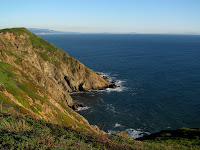
 Point Reyes is separated geographically from the rest of the Northern California coast by Bolinas Lagoon, the Olema Valley, and Tomales Bay. It is separated geologically by the San Andreas Fault, which bisects all three of these features. That means Point Reyes is on the Pacific Plate and heading north relative to most of northern California, which is still attached to North America. It's geolgoic affiliation is really with the coast much farther south - and ultimately with rocks that belong in Southern California. The headland of Point Reyes is Cretaceous granite, much of the peninsula is Miocene sediments, and much of the west side is mantled in both ancient and modern sand dunes.
Point Reyes is separated geographically from the rest of the Northern California coast by Bolinas Lagoon, the Olema Valley, and Tomales Bay. It is separated geologically by the San Andreas Fault, which bisects all three of these features. That means Point Reyes is on the Pacific Plate and heading north relative to most of northern California, which is still attached to North America. It's geolgoic affiliation is really with the coast much farther south - and ultimately with rocks that belong in Southern California. The headland of Point Reyes is Cretaceous granite, much of the peninsula is Miocene sediments, and much of the west side is mantled in both ancient and modern sand dunes.The beach on the ocean side consists of a long strand of coarse sand extending north from the headland. It's backed by dunes and low bluffs cut into much older dunes. The aerial shows the dunes climbing southeastward up the long western slope, which says something about the prevailing winds.
AERIAL VIEW
 The dunes are largely stabilized by non-native European beach grass and Ice Plant. Dunes are like meandering rivers and receding coastal bluffs - they are supposed to erode. And if they can't - due to levees or seawalls or invasive vegetation, the landscape and the ecology begins to change. The ice plant was beautiful in its winter colors -- even if there was far too much of it!
The dunes are largely stabilized by non-native European beach grass and Ice Plant. Dunes are like meandering rivers and receding coastal bluffs - they are supposed to erode. And if they can't - due to levees or seawalls or invasive vegetation, the landscape and the ecology begins to change. The ice plant was beautiful in its winter colors -- even if there was far too much of it! 




0 Response to "Point Reyes"
Posting Komentar